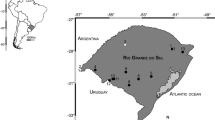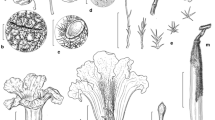Abstract
Phlox pilosa ssp.pilosa andP. pilosa ssp.fulgida form a zone of secondary intergradation extending from northern Illinois and Indiana along the prairie-forest border to southwestern Missouri. The structure of the zone was analyzed in Illinois and Indiana. Trichome morphology offered the only diagnostic characteristic. Character gradients in the zone are highly irregular and steeply sloping. Closely adjacent populations often have disparate phenotype distributions. Most populations are strongly skewed toward the parental ends of the morphological spectrum. The properties of the zone are attributed to genome incompatibility, which is seen in the crossability barriers between the two subspecies and between the subspecies and hybrids, a reduction in pollen fertility, anther size and fecundity in hybrids, and the formation of multiple nucleoli in the hybrids. Subspeciesfulgida appears to be the primary recipient of alien gene flow. However, the position of the zone ostensibly is stabilized by the presence of an ecological barrier.
Similar content being viewed by others
Literature cited
Bigelow, R. S. 1965. Hybrid zones and reproductive isolation. Evolution19: 449–458.
Broecker, W. S. &W. R. Farrand 1963. Radiocarbon age of the Two Creek forest bed, Wisconsin. Bull. Geol. Sci. Amer.74: 795–802.
Crosby, J. L. 1966. Reproductive capacity in the study of evolutionary processes. pp. 122–128.In: J. G. Hawkes [Editor], Reproductive Biology and Taxonomy of Vascular Plants. New York: Pergamon Press. 183 pp.
Deevey, E. S. &R. F. Flint 1957. Postglacial hypsithermal interval. Science125: 182–184.
Dessauer, H. C., W. Fox, &F. H. Pough 1962. Starch-gel electrophoresis of transerrins, esterases, and other plasma proteins of hybrids between two subspecies of whiptail lizard (genusCneidophorus). Copeia1962: 767–774.
Grant, V. 1966. Species hybrids and spontaneous amphiploids in theGilia laciniata group. Heredity20: 537–550.
Hadley, E. B. &D. A. Levin 1969. Species contact inPhlox: control and response. Amer. Midland Nat.82: 490–511.
Levin, D. A. 1964. Variation and evolution inPhlox subsectionDivaricatae. Thesis: Ph.D. University of Illinois, Urbana. 133 pp.
—. 1966. ThePhlox pilosa complex crossing and chromosome relationships. Brittonia18: 142–162.
—. 1967. Variation inPhlox divaricata. Evolution21: 92–108.
—. 1968. The genome constitutions of eastern North AmericanPhlox amphiploids. Evolution22: 612–632.
— &H. W. Kerster 1967. An analysis of interspecific pollen exchange inPhlox. Amer. Naturalist101: 387–400.
— &H. W. Kerster. 1968. Local gene dispersal inPhlox. Evolution22: 130–139.
— &H. W. Kerster. 1970. Phenotypic dimorphism and population fitness inPhlox pilosa. Evolution24: 128–134.
— &Barbara A. Schaal 1970. Reticulate evolution inPhlox as seen through protein electrophoresis. Amer. Jour. Bot.57: 977–987.
Mayr, E. 1942. Systematics and Origin of Species. New York: Columbia Univ. Press. 334 pp.
—. 1963. Animal Species and Evolution. Cambridge, Massachusetts: Belknap Press. 797 pp.
Richards, L. A. 1949. Methods of measuring soil moisture tension. Soil Science68: 59–112.
Smith, E. B. 1968. Pollen competition and relatedness inHaplopappus sectionIsopappus. Bot. Gaz.129: 371–373.
—. 1970. Pollen competition and relatedness inHaplopappus sectionIsopappus (Compositae) II. Amer. Jour. Bot.57: 874–880.
Walker, S. A. 1969. Cytological and Chromatographic evidence for interspecific hybridization inPetalostemon. Ann. Missouri Bot. Gard.56: 261–267.
Wherry, E. T. 1930. The eastern short-styled phloxes. Bartonia12: 24–53.
—. 1955. The genusPhlox. Philadelphia, Pennsylvania: Morris Arboretum Monogr.III. 174 pp.
Woodson, R. E., Jr. 1947. Some dynamics of leaf variation inAsclepias tuberosa. Ann. Missouri Bot. Gard.34: 353–432.
—. 1962. Butterflyweed revisited. Evolution16: 168–185.
Author information
Authors and Affiliations
Rights and permissions
About this article
Cite this article
Levin, D.A., Levy, M. Secondary intergradation and genome incompatibility in Phlox pilosa (polemoniaceae). Brittonia 23, 246–265 (1971). https://doi.org/10.2307/2805627
Issue Date:
DOI: https://doi.org/10.2307/2805627




